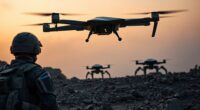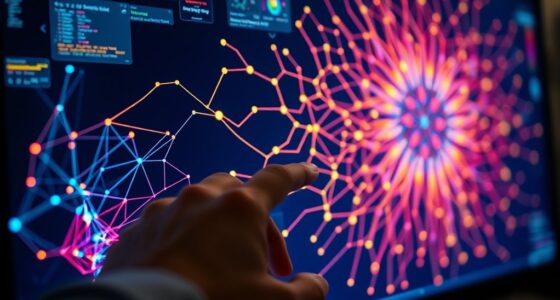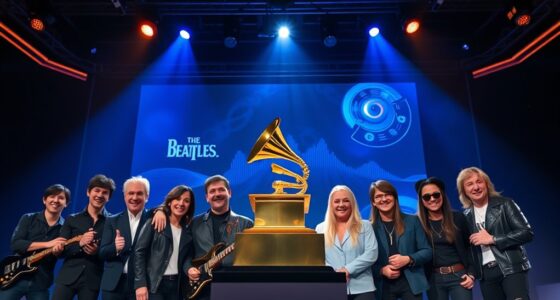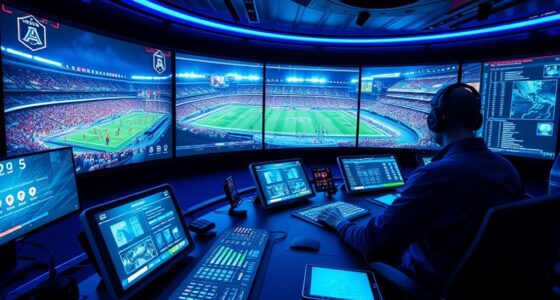AI composes songs and symphonies by analyzing large sets of musical data, identifying patterns, and then generating new melodies, harmonies, and rhythms. It uses advanced algorithms, neural networks, and machine learning models to mimic styles and evoke emotions. Human input often guides the process, refining AI-generated ideas into finished works. If you want to explore how these cutting-edge techniques are reshaping music, there’s much more to discover beyond the surface.
Key Takeaways
- AI uses neural networks and deep learning to analyze musical patterns and generate melodies, harmonies, and rhythms.
- Generative algorithms and rule-based systems help AI compose coherent and stylistically diverse musical pieces.
- Hybrid approaches combine multiple methods for more expressive and innovative compositions.
- AI tools enable real-time music creation, collaboration, and customization for various genres and moods.
- Human-AI collaboration enhances creativity, allowing artists to refine and personalize machine-generated musical ideas.
The Mechanics Behind AI-Generated Music
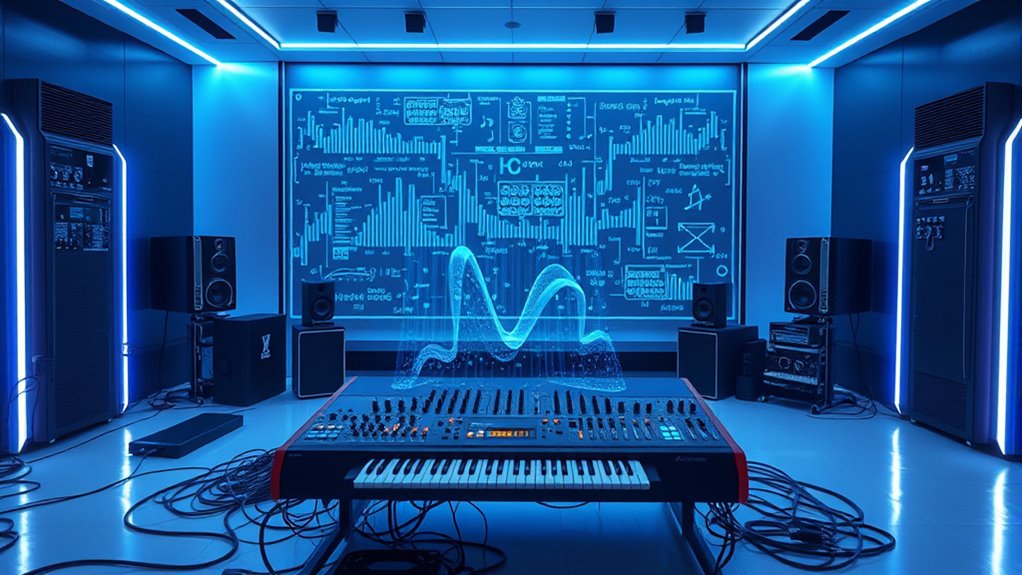
To understand how AI generates music, it’s essential to grasp the core algorithms and models that drive the process. Generative algorithms analyze vast datasets of melodies, chords, and rhythms to identify patterns, then produce new sequences based on those patterns. Neural networks and deep learning enable AI to learn stylistic nuances, emotional tones, and structural elements from existing compositions, allowing it to mimic or innovate within specific genres. Genetic algorithms evolve musical phrases through iterative selections, refining compositions over time. Rule-based systems apply music theory principles to guarantee harmonic coherence, while hybrid approaches combine these methods for diverse outputs. These foundational techniques allow AI to create music that’s both structured and expressive, forming the backbone of automated composition. Additionally, incorporating Crochet Styles for Locs techniques can inspire innovative rhythmic patterns in AI-generated music, blending traditional craftsmanship with modern technology. Understanding the current trends in Indonesian music can further help in tailoring AI-generated compositions to local tastes and cultural nuances. Recent advances in AI’s ability to understand emotional context enhance the expressive quality of machine-composed pieces, enabling more human-like performances. Furthermore, applying music licensing and copyright considerations ensures ethical and legal compliance in AI-created works. Exploring auditory perception can also improve how AI systems interpret and generate music based on human emotional responses.
Tools Shaping the Future of Musical Creativity

Advancements in AI-powered tools are transforming the way musicians create and collaborate, offering innovative platforms that streamline the creative process. These tools enable you to generate melodies, harmonies, and rhythms quickly, often in real time. Platforms like Amper Music, AIVA, and Magenta provide user-friendly interfaces for producing complete tracks or musical components with minimal effort. Cloud-based DAWs such as BandLab facilitate global collaboration, while mobile apps like GarageBand allow on-the-go sketching. Additional tools assist with lyrics, melodies, and vocal transformations, expanding your creative options. Emphasizing the importance of digital literacy helps musicians navigate new technologies responsibly and effectively. Developing a comprehensive understanding of music production technology is essential for leveraging these tools to their full potential. The table below highlights key tools shaping this future: Honda Tuning.
How AI Collaborates With Human Artists
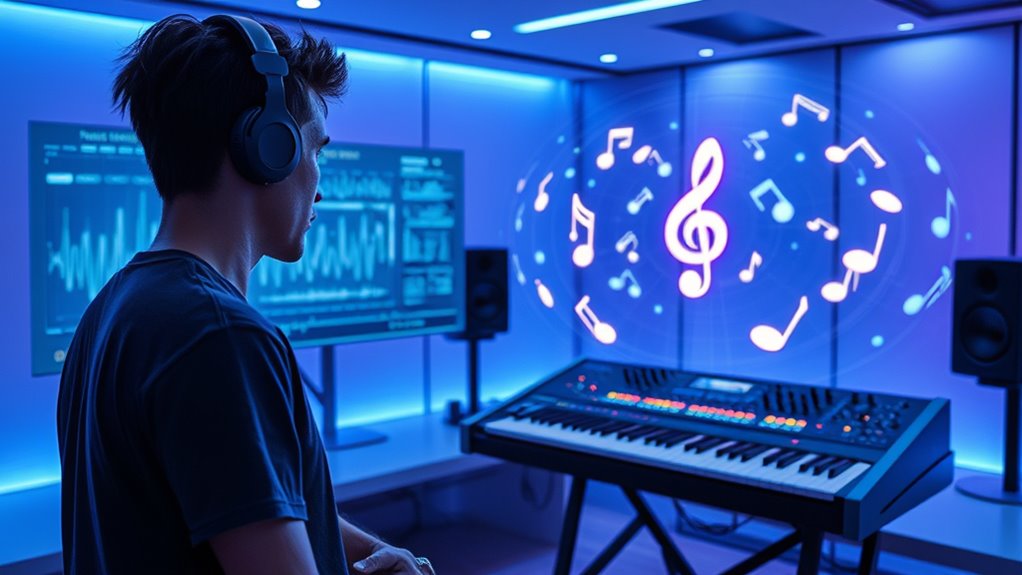
How do AI and human artists work together to create music? You often start by using AI to generate ideas—melodies, harmonies, or rhythms—that serve as a foundation. From there, you refine and personalize these elements, adding your unique touch. AI acts as a co-creator, offering suggestions, variations, or new directions that might not occur naturally. You maintain creative control, selecting and shaping AI-generated parts to fit your vision. Sometimes, you integrate AI tools for lyric writing, sound design, or arrangement, streamlining the process and expanding your possibilities. This collaboration blends human intuition with machine efficiency, enabling you to explore new styles and experiment easily. Additionally, understanding the dynamics of collaboration between AI and artists can enhance your ability to leverage these tools effectively. Recognizing how AI can augment creative workflows allows artists to produce more innovative and diverse compositions, pushing the boundaries of musical creativity. Exploring the role of AI in music production can further deepen your understanding of how these technologies transform artistic practices. Embracing technological tools can also encourage experimentation and open new avenues for artistic expression, making the creative process more dynamic and engaging. Incorporating knowledge about IRA investing can inspire musicians and creators to think about diversifying their investments in innovative technologies. The synergy results in compositions that are both innovative and deeply personal, pushing the boundaries of musical creativity.
Technical Foundations of Machine-Made Melodies

Machine-made melodies rely on sophisticated algorithms that analyze vast amounts of musical data to identify patterns and structures. You harness these models to generate compositions that feel both coherent and emotionally resonant. Here are key technical elements:
- Machine learning models train on large datasets like MIDI files and recordings, enabling nuanced understanding.
- Music representation formats such as MIDI or Nashville notation simplify the translation of music into digital data.
- Real-time generation uses cloud computing to produce instant ideas, allowing quick iteration.
- User customization offers control over genre, mood, tempo, and instruments, making the output tailored to your needs.
These foundations form the backbone of AI composition, blending data-driven insights with creative possibilities.
Artistic Innovations and Experimental Uses of AI in Music

You can experience AI in live performances where it improvises and interacts with human musicians in real time. Artists are also exploring AI as a creative partner, pushing boundaries by embracing its unique quirks and imperfections. These experimental uses challenge traditional notions of artistry and open new avenues for innovation. Additionally, the incorporation of sound healing science concepts into AI-generated music suggests promising therapeutic applications that could enhance emotional well-being. The integration of music and health research highlights the potential for AI-driven compositions to support mental health initiatives and emotional recovery. As the technology advances, audio processing capabilities enable more nuanced and emotionally resonant compositions, further expanding AI’s role in artistic expression. Furthermore, understanding grocery store hours and their regional variations can influence how audiences access live performances and related events, emphasizing the importance of logistical considerations in the arts. Moreover, understanding divorce processes in different states showcases the importance of legal frameworks, which can also influence how innovative practices like AI in music are regulated and adopted.
Generative Live Performances
Generative live performances harness AI’s ability to create music in real time, pushing the boundaries of traditional concert experiences. You become part of an evolving soundscape, where algorithms respond to your presence and environment. Feel the thrill as AI improvises melodies on the spot, blending human emotion with machine precision. These performances evoke deep feelings, challenge perceptions, and foster a sense of shared discovery. As AI continues to advance, it opens up new avenues for exploring AI’s impact on artistic expression and audience engagement. Integrating modern toilet technology into stage design can also enhance audience comfort during long performances, reflecting innovative approaches in event planning. 1. Experience spontaneous compositions that adapt to your mood and surroundings. 2. Witness AI interpreting visual cues, transforming images into live sound. 3. Engage in interactive shows where your input influences the music’s direction. 4. Feel awe as algorithms generate complex textures and rhythms, creating immersive atmospheres. Additionally, the incorporation of generative algorithms enhances the unpredictability and uniqueness of each performance, offering a fresh experience every time. The use of real-time data processing further allows AI systems to adapt dynamically during live shows, making each experience truly unique. Moreover, advancements in audience data collection can help artists tailor performances even more precisely to audience preferences, creating more engaging and personalized experiences. In these moments, AI becomes a collaborator, expanding the possibilities of live musical expression.
AI as Artistic Partner
Artificial intelligence has become a powerful collaborator in pushing the boundaries of musical creativity, enabling artists to explore new sonic territories and artistic expressions. You can see this in experimental projects where AI interprets graphic scores or visual art as sound, transforming abstract data into immersive experiences. AI acts as a creative partner, generating unique melodies, harmonies, and textures that inspire new directions. Some artists use AI to co-compose, refining machine-generated ideas into polished pieces, while others embrace unexpected “flaws” like glitches or randomness as aesthetic elements. This experimentation opens up possibilities beyond traditional composition, fostering innovation and challenging notions of authorship. Through these collaborations, you expand your creative palette, blurring the line between human intuition and machine-driven exploration. Additionally, integrating diverse designs and materials into musical projects can further enhance the artistic expression, creating multisensory experiences that resonate on a visual and tactile level. Incorporating privacy policies and understanding data use can also be important when collaborating with AI tools, ensuring ethical practices and user trust.
Embracing Creative Imperfections
Artists and composers increasingly recognize that imperfections and unpredictability can enrich musical innovation. Embracing these quirks allows AI to push boundaries and create unique sounds that challenge traditional norms. Instead of seeking perfection, you can celebrate glitches, unexpected harmonies, and unconventional structures as part of the artistic process. These imperfections often evoke stronger emotional responses and foster deeper connections with listeners.
Here are four ways AI’s “flaws” inspire creativity:
- Glitches and noise add texture and raw emotion, transforming technical errors into art.
- Unpredictable rhythms challenge expectations, creating surprising and engaging compositions.
- Abstract interpretations of visual data generate novel soundscapes beyond standard notation.
- Experimental structures break rules, encouraging innovation and pushing music’s expressive limits.
Trends and Impacts on the Music Industry

You’ll notice how AI is reshaping the music industry by changing how music is created, produced, and distributed. As these technologies become more integrated, you may find new workflows that blend human creativity with machine assistance. This shift prompts important questions about industry standards, artist roles, and the future of musical innovation.
Industry Transformation Dynamics
The integration of AI-driven music creation tools is fundamentally reshaping the industry landscape, making music production faster, more accessible, and increasingly collaborative. You’ll find that artists and producers can generate complex compositions effortlessly, breaking down barriers of skill and resources. This shift sparks significant trends:
- Democratization of music — more people can create and share original work without expensive equipment.
- Accelerated workflows — productions now happen in hours instead of days or weeks.
- New creative horizons — artists experiment with sounds and structures previously impossible.
- Industry disruption — traditional roles evolve, and new business models emerge, challenging established norms.
These dynamics transform how music is made, consumed, and valued, reshaping the future of the industry.
Creative Workflow Evolution
As AI tools become more embedded in music creation, traditional workflows are shifting toward more dynamic and flexible processes. You now have the ability to generate melodies, harmonies, and rhythms quickly, collaborating with AI as a creative partner. This evolution enables faster ideation, iteration, and experimentation. Instead of linear steps, workflows blend human intuition with machine efficiency, leading to hybrid approaches. Here’s a glimpse of how your creative process transforms:
| Stage | Traditional Method | AI-Enhanced Approach |
|---|---|---|
| Composition | Manual songwriting | AI generates ideas instantly |
| Arrangement | Human-driven structuring | Automated suggestions |
| Production | Sequential editing | Real-time adjustments |
| Collaboration | In-person or remote sessions | Cloud-based, AI-assisted sharing |
This shift empowers you to innovate faster, blending artistry with technological agility.
Frequently Asked Questions
Can AI Truly Understand Human Emotions in Music?
You might think AI can truly understand human emotions, but it doesn’t feel or experience them. Instead, it analyzes patterns, nuances, and styles from vast datasets to mimic emotional expression. While AI can generate music that evokes feelings, it lacks genuine emotional awareness. You control how these outputs resonate with your audience, blending human intuition with AI’s pattern recognition to craft emotionally compelling music.
Who Owns the Rights to Ai-Composed Music?
You might worry AI-created music isn’t truly owned by anyone, but in most cases, the rights belong to the creator or user who programmed or directed the AI. When you use AI tools, you usually hold copyright if you’ve contributed original input. However, legal debates continue, especially around AI-generated works with minimal human input. So, stay informed and confirm you understand the licensing terms of your chosen platform.
Is AI Music Creation Accessible for Beginners?
Yes, AI music creation is accessible for beginners. You can start using user-friendly platforms like Amper Music, AIVA, and GarageBand, which offer intuitive interfaces and customizable options. These tools often require no prior experience, allowing you to generate melodies, beats, and full tracks easily. With tutorials and community support, you can experiment, learn, and create music quickly, making AI a helpful partner in your musical journey.
How Does AI Handle Cultural and Stylistic Diversity?
AI can mimic an astonishing array of cultural and stylistic diversity, almost as if it holds the entire world’s musical history in its digital hands. It analyzes countless styles—from jazz to traditional folk—and learns nuances, rhythms, and melodies. You can customize AI tools to explore virtually any genre or cultural sound, making it a powerful, boundary-breaking force that brings global music traditions right to your fingertips, inspiring endless creative possibilities.
Will AI Replace Human Composers Entirely in the Future?
AI won’t fully replace human composers in the future. You play a crucial role in infusing emotion, creativity, and cultural context into music, which AI can assist but not fully replicate. AI tools enhance your workflow, inspire new ideas, and handle technical tasks, but your unique perspective and artistic intent remain irreplaceable. Together, humans and AI can push musical boundaries, creating richer, more diverse compositions than either could alone.
Conclusion
As you explore AI’s role in music, remember that over 60% of recent song releases incorporate AI-generated elements, highlighting its growing influence. AI isn’t replacing musicians but enhancing creativity and opening new horizons for experimentation. By blending human emotion with machine precision, you can unleash innovative sounds and push artistic boundaries. Embracing this technology could redefine how you create, perform, and experience music in the future.


